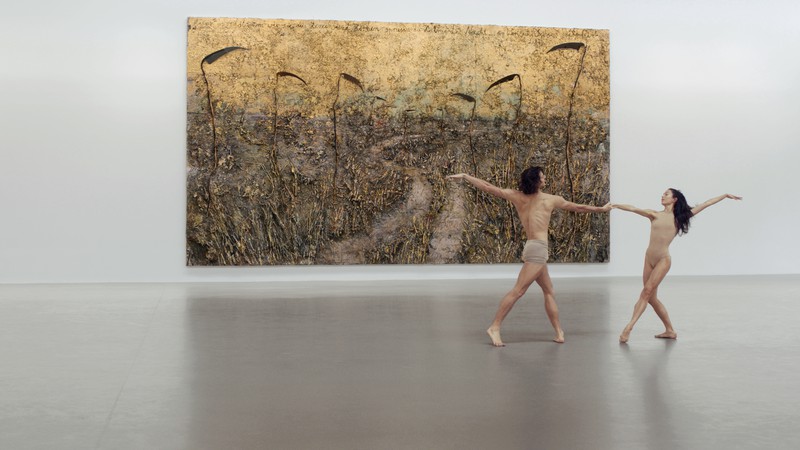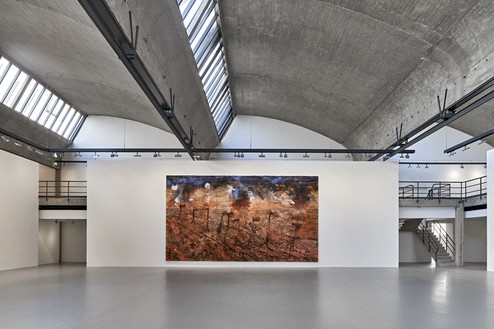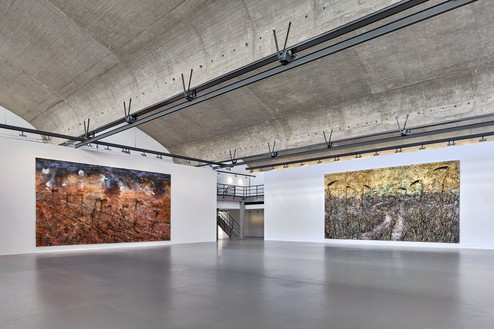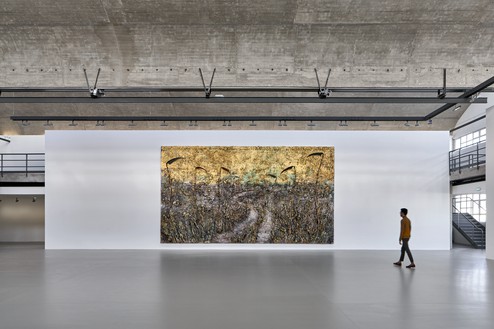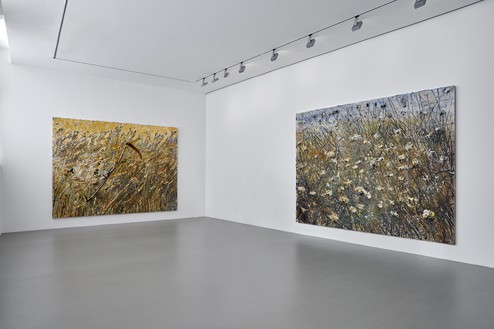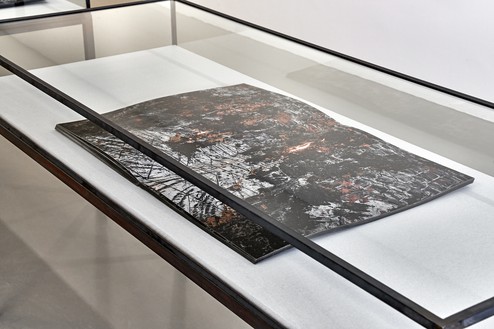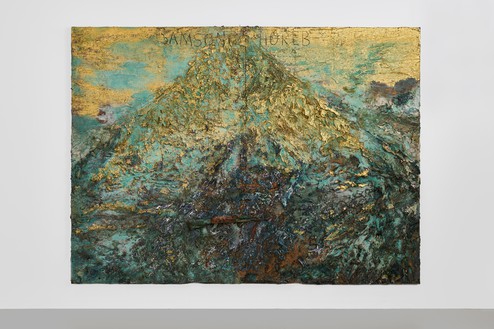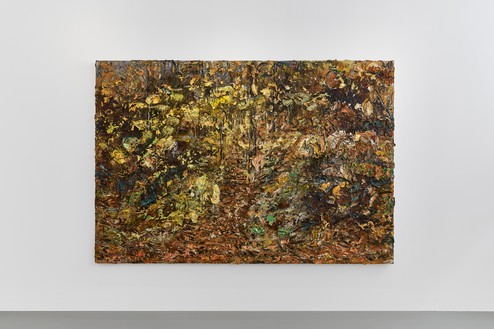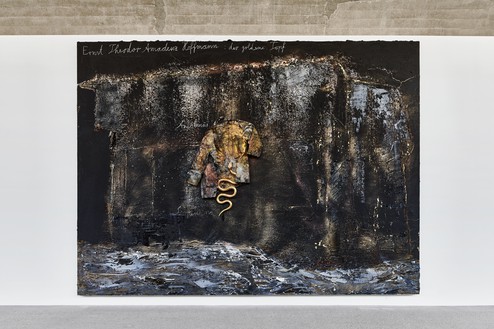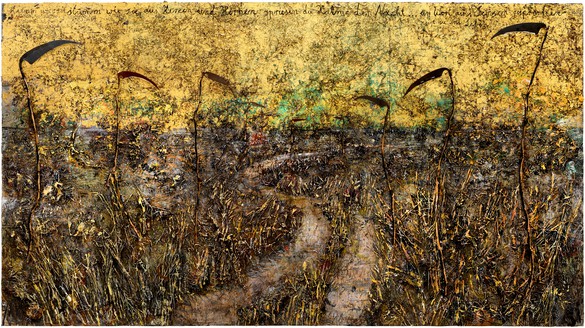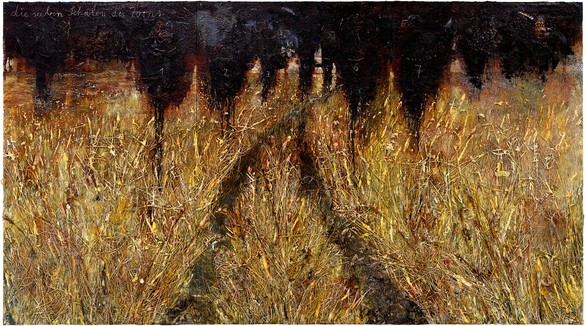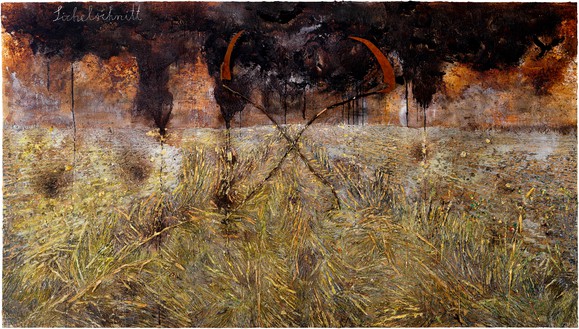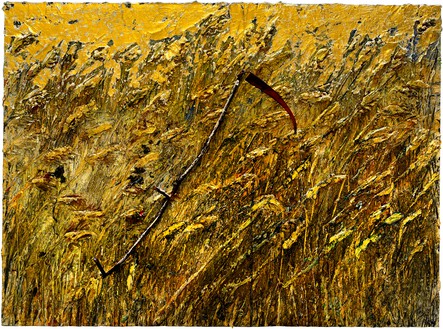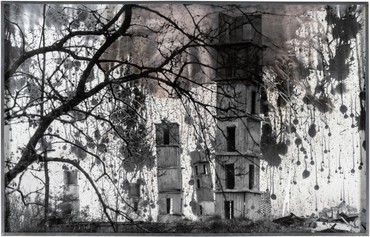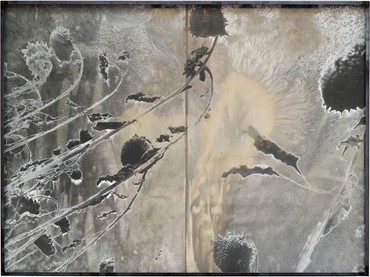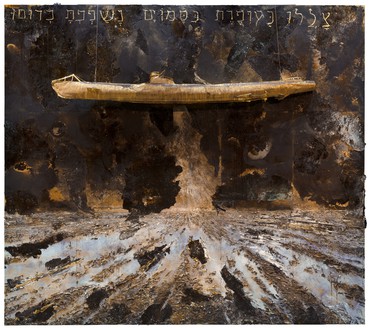Extended through June 26, 2021
About
What interests me is the transformation, not the monument. I don’t construct ruins, but I feel ruins are moments when things show themselves. A ruin is not a catastrophe. It is the moment when things can start again.
The pictures become interesting when the subject matter is no more than an excuse, when the artist remembers the struggle, when he sets forth his own world in conflict with the self-secluding earth.
—Anselm Kiefer
Gagosian is pleased to present Field of the Cloth of Gold, an exhibition of four monumental new paintings by Anselm Kiefer.
The tension between beauty and terror, alongside the inextricable relationship between history and place, has animated Kiefer’s work since the 1970s. Drawing on the literature of cultural memory—including poetry, the Old and New Testaments, and the Kabbalah—Kiefer gives material presence to myths and metaphors. He infuses the medium of paint with startling and unconventional gestures and objects, juxtaposing it with organic and abject materials such as straw, sand, charcoal, ash, and mud. Kiefer asserts himself as an iconoclast; his paintings undergo various processes—such as being cut, burned, buried, exposed to natural elements, splashed with acid, or poured over with lead—so as to be made anew. These strategies, along with the use of materials such as lead, concrete, glass, fabric, tree roots, or burned books, create a symbolic resonance, making palpable both the movement and destruction of human life and the persistence of the lyrical and the divine.
Ce qui m’intéresse, c’est la transformation, pas le monument. Je ne construis pas de ruines, mais j’ai le sentiment que les ruines sont des moments où les choses se montrent telles qu’elles sont. C’est le moment où les choses peuvent recommencer.
Les images deviennent intéressantes quand le sujet n’est plus qu’une excuse, quand l’artiste se souvient de la lutte, quand il oppose son propre monde en conflit avec la terre qui s’est isolée d’elle-même.
—Anselm Kiefer
Gagosian est heureuse de présenter Field of the Cloth of Gold, une exposition de quatre nouvelles peintures monumentales d’Anselm Kiefer.
La tension entre la beauté et l’effroi, aux côtés du rapport inextricable entre l’histoire et le lieu ont animé le travail de Kiefer depuis les années 1970. Puisant dans la littérature de la mémoire culturelle – et notamment la poésie, l’Ancien et le Nouveau Testament et la Kabbalah – Kiefer donne une présence matérielle aux mythes et aux métaphores. Il imprègne le médium de la peinture de gestes et d’objets non conventionnels et étonnants, en le mêlant à des matières organiques et pauvres telles que la paille, le sable, le charbon, les cendres ou la boue. Kiefer se définit lui-même comme un iconoclaste ; ses peintures subissent divers processus – elles sont coupées, brûlées, enterrées, exposées aux éléments naturels, éclaboussées avec de l’acide ou arrosées de plomb – pour être recréées à nouveau. Ces stratégies, avec l’usage de matériaux tels que le plomb, le béton, le verre, le tissu, des racines d’arbres ou des livres brûlés créent une résonance symbolique, rendant ainsi tangibles le mouvement et la destruction de la vie humaine et la persistance du lyrique et du divin.
Le titre de l’exposition fait référence au sommet de paix historique entre les rois Henry VIII et François 1er qui s’est tenu il y a cinq-cents ans au beau milieu d’un champ, dans ce qui est désormais le Pas-de-Calais. La réunion, centrée autour d’une alliance stratégique entre l’Angleterre et la France, avait pour but de proscrire la guerre entre les nations chrétiennes. Cette alliance est considérée comme un événement fondateur du façonnement de la géopolitique européenne – jusqu’à ce qu’elle soit dissoute et que la guerre éclate, un an plus tard. Bien que Kiefer n’ait pas commencé à concevoir ces œuvres en ayant cet événement ou même ce titre à l’esprit, la connexion devint évidente et simultanée à leur achèvement. Comme il l’a déclaré récemment dans une interview, « le titre souvent n’est pas une explication de l’œuvre » mais plutôt « une allusion ». L’histoire est l’un des médiums qu’il utilise et synthétise dans son œuvre, « comme l’argile pour le sculpteur et la couleur pour le peintre. »
Achevées durant ces deux dernières années, ces œuvres sont antérieures à la pandémie de COVID-19, à la crise qu’elle a entrainée et à la reconfiguration des relations internationales et interculturelles qu’elle a engendrée. Alors que l’histoire a été fracturée et imprévisible depuis la rencontre diplomatique du camp du Drap d’Or, notre mémoire culturelle retient l’imprévisibilité violente des relations humaines dans un continuum. L’aspect stratifié et viscéral de ces peintures, dont l’échelle correspond presque aux paysages qu’elles représentent, évoque le caractère versatile grandissant de l’histoire européenne et les effets et séquelles de la guerre. Comme dans la série des Morgenthau Plan de 2012, Anselm Kiefer appose d’autres éléments à la surface de ces peintures, de la matière végétale à du matériau industriel, construisant ainsi une troisième dimension à même la toile peinte. Ici le champ de l’histoire est transfiguré en un champ d’or sous un ciel sombre.
Comme souvent dans le travail de Kiefer, le titre et les symboles de chaque peinture contiennent un riche ensemble de références littéraires et historiques. Sichelschnitt (2019) fait référence au Plan Jaune (Sichelschnittplan), une stratégie conçue par l’armée allemande pendant la bataille de France en 1940, tandis que Beilzeit—Wolfszeit (2019) fait allusion à « Völuspá » (Prophétie de la Voyante), le premier poème de l’Edda Poétique issu de la mythologie nordique. Le verset 45 de ce poème est ainsi traduit « Temps de la hache – temps de l’épée, | les boucliers sont brisés, / Temps du vent, temps du loup, | avant que le monde ne s’effondre. » Ein Wort von Sensen gesprochen (2019–20) évoque le poème « From Hearts and Brains » de Paul Celan dont la poésie a été un point de référence pour Kiefer depuis des décennies. Le verset de Celan lit « et un mot, prononcé par les faux / les amènent à la vie. »
Share
Artist
In Conversation
Jerome Rothenberg and Charles Bernstein
Gagosian and Beyond Baroque Literary | Arts Center hosted a conversation between poets Jerome Rothenberg and Charles Bernstein inside Anselm Kiefer’s exhibition Exodus at Gagosian at Marciano Art Foundation, Los Angeles. Rothenberg and Bernstein explored some of the themes that occupy Kiefer—Jewish mysticism, the poetry of Paul Celan, and the formulation of a global poetics in response to the Holocaust—in a discussion and readings of their poetry.
In Conversation
Anselm Kiefer and Michael Govan
On the occasion of his exhibition Anselm Kiefer: Exodus at Gagosian at Marciano Art Foundation in Los Angeles, the artist spoke with Michael Govan about his works that elaborate on themes of loss, history, and redemption.
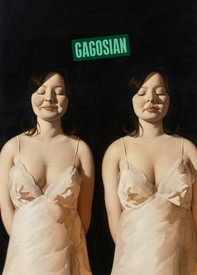
Now available
Gagosian Quarterly Winter 2022
The Winter 2022 issue of Gagosian Quarterly is now available, featuring Anna Weyant’s Two Eileens (2022) on its cover.
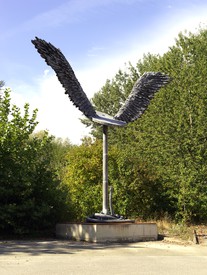
Hans Ulrich Obrist’s Questionnaire: Anselm Kiefer
In this ongoing series, curator Hans Ulrich Obrist has devised a set of thirty-seven questions that invite artists, authors, musicians, and other visionaries to address key elements of their lives and creative practices. Respondents make a selection from the larger questionnaire and reply in as many or as few words as they desire. For the fourth installment, we are honored to present the artist Anselm Kiefer.
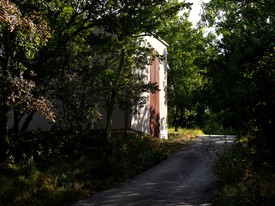
Anselm Kiefer: Architect of Landscape and Cosmology
Jérôme Sans visits La Ribaute in Barjac, France, the vast studio-estate transformed by Anselm Kiefer over the course of decades. The labyrinthine site, now open to the public, stands as a total work of art, reflecting through its grounds, pavilions, and passageways major themes in Kiefer’s oeuvre: regeneration, mythology, memory, and more.
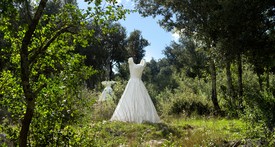
La Ribaute: Transitive, It Transforms
Camille Morineau writes of the triumph of the feminine at Anselm Kiefer’s former studio-estate in Barjac, France, describing the site and its installations as a demonstration of women’s power, a meditation on inversion and permeability, and a reversal of the long invisibility of women in history and myth.
News

Artist Spotlight
Anselm Kiefer
June 22–28, 2022
Anselm Kiefer’s monumental body of work represents a microcosm of collective memory, visually encapsulating a broad range of cultural, literary, and philosophical allusions. Drawing from sources that range from the Old and New Testaments, Kabbalah mysticism, Norse mythology, and Wagner’s Ring Cycle to the poetry of Ingeborg Bachmann and Paul Celan, Kiefer makes palpable the complexities of human history.
Photo: Georges Poncet
